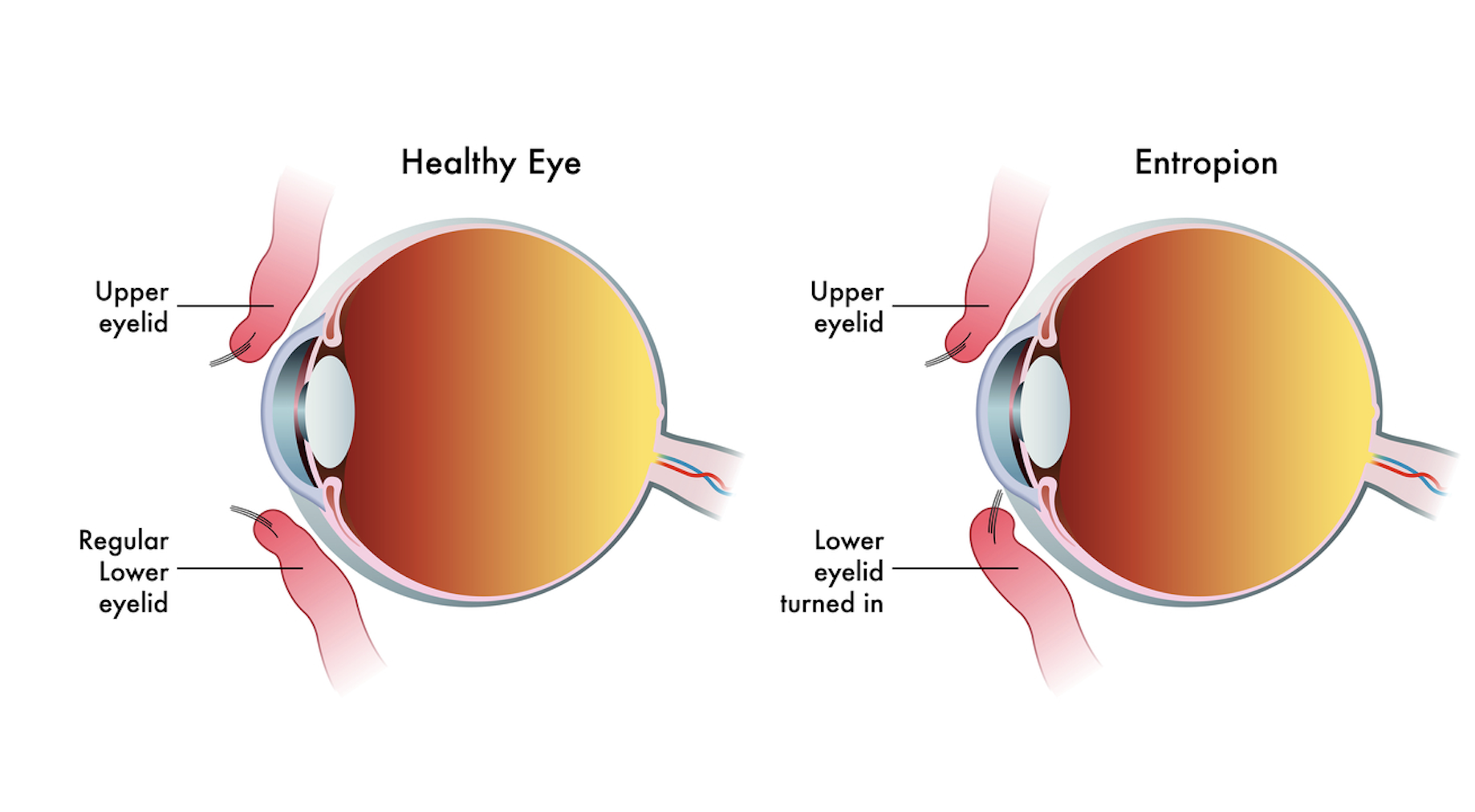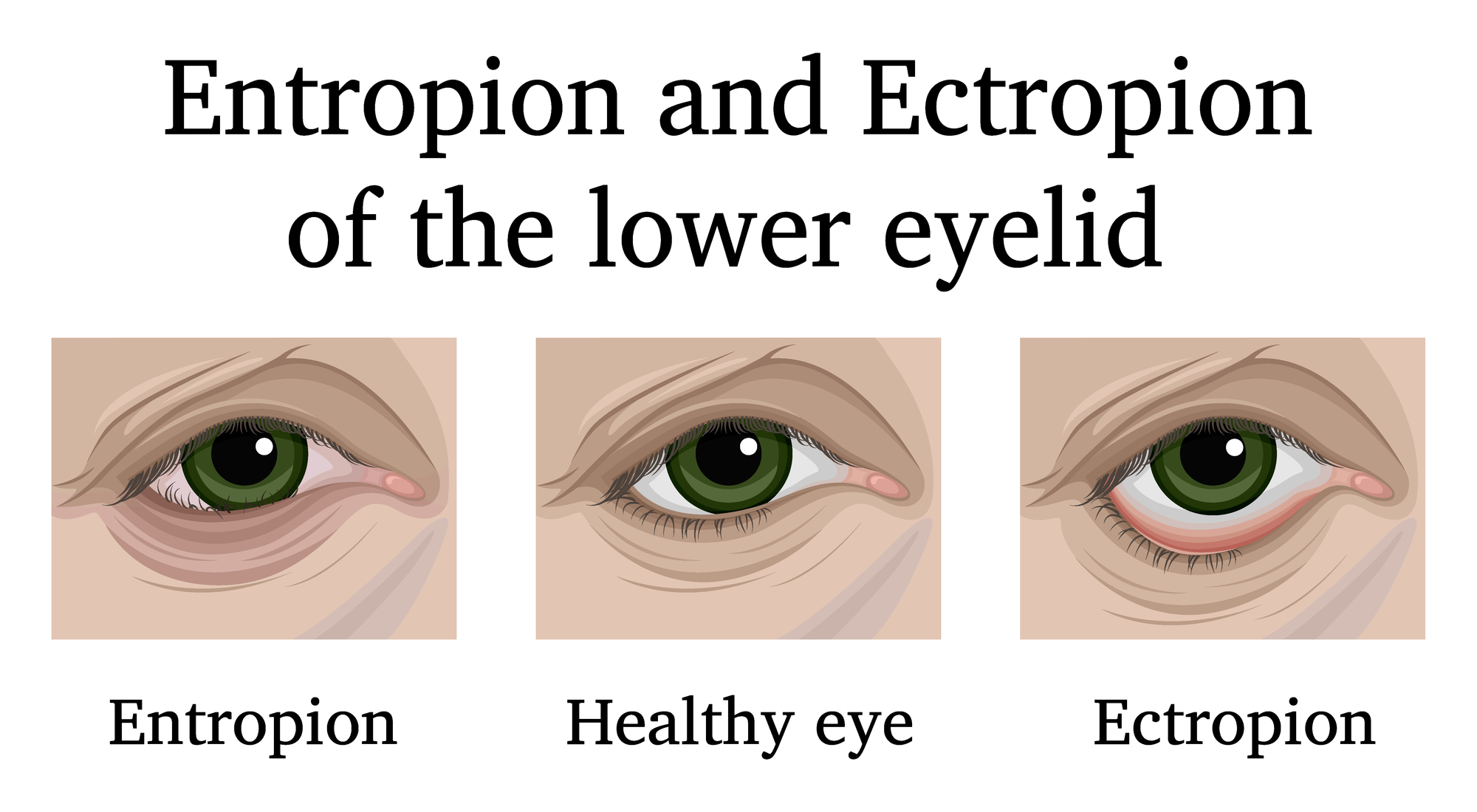Updated on May 1, 2024
What is Entropion Surgery?


Vision Center is funded by our readers. We may earn commissions if you purchase something via one of our links.
What is Entropion (Eyelid Turning in)?
Entropion is a condition in which the eyelid margin turns inward. The eyelid skin and eyelashes rub against the eye’s surface, causing discomfort and irritation. The cornea (clear dome in front of the eye) is also affected in many cases.

Entropion can lead to corneal irritation, eye infections, and even vision loss if left untreated. Fortunately, there are several ways to treat entropion, including artificial tears, botulinum toxin (Botox) injections, and surgery.
What are the Symptoms of Entropion?
With entropion, the lower eyelids can turn in at all times or when squeezing the eyelids shut or blinking too hard.
Symptoms associated with entropion include:
- Blurred vision
- Foreign body sensation
- Eye infection
- Corneal abrasion
- Irritation on the surface of the eye and around the eyes
- Eye redness
- Dry eye
- Eye pain and discomfort
- Excessive tearing (epiphora or mucous discharge)
- Light sensitivity (photophobia)
- Wind sensitivity
- Sagging eyelid skin
Is Entropion Common?
Entropion is rare in children. However, it’s among the most common eyelid malpositions in older adults.
According to the American Academy of Ophthalmology, entropion occurs in up to 2.1% of people over 60.2
Is Entropion Serious?
Without treatment, entropion can lead to serious complications and permanent vision loss.
Potential complications of entropion include:
- Corneal injury
- Corneal ulcer
- Corneal abrasions
When to See a Doctor
Schedule an appointment with your doctor if you notice your eyelashes turning in toward your eye or other symptoms of entropion.
Seek immediate medical care if you experience symptoms of corneal irritation, such as:
- Rapidly worsening eye redness
- Decreased vision
- Light sensitivity
- Eye pain
How is Entropion Diagnosed?
A physician or an eye doctor can diagnose entropion with a routine eye exam. Diagnostic tests are generally not necessary.
Types of Entropion
Entropion can be unilateral (affecting one eye) or bilateral (both eyes). It can involve the upper and lower eyelids, but the most common type only affects the lower eyelid.
There are four types of entropion:
- Congenital. This type of entropion is present at birth.
- Involutional. The most common type of lower eyelid entropion.
- Acute spastic. This type can result from an eye infection or inflammation in people predisposed to involutional entropion.
- Cicatricial. The most common type of upper lid entropion.
What Causes Entropion?
People are more likely to develop entropion as they age, except those with congenital entropion.
Causes and risk factors for entropion also vary depending on the type:
Causes of Involutional Lower Eyelid Entropion
Involutional entropion results from age-related weakening of the eyelid muscles and canthal tendons. This is called horizontal eyelid laxity, and it causes eyelid margin malpositioning.
Causes of Acute Spastic Entropion
The leading causes of acute spastic entropion are infection, inflammation, and eye irritation. This most commonly occurs after a person with involutional eyelid changes undergoes eye surgery.
Causes of Cicatricial Entropion
This type of entropion is caused by scar tissue. Risk factors include prior eye trauma, infection, and/or inflammation.
Entropion vs. Ectropion
Entropion is the inward turning of the eyelid. Ectropion is when the eyelid turns outward.
Ectropion generally affects the lower eyelid. It leaves the underside of the eyelid exposed, increasing the risk of irritation and infection. The eyeball will also appear more open.

As with entropion, ectropion is largely an age-related condition. There are ways to treat the symptoms of ectropion. However, surgical correction is the only way to repair the problem permanently.
How is Entropion Treated?
Surgery can only permanently fix entropion; nonsurgical treatments only provide temporary relief.
Management and treatment for entropion might include:
Artificial Tears
Lubricating eye drops (artificial tears) help maintain moisture in the eye and relieve discomfort. However, eye drops can only provide short-term relief.
Soft Contact Lenses
Soft contact lenses can act as a bandage for people with entropion. They help protect against corneal irritation. Soft contacts are available with or without a prescription.
Botulinum Toxin Injection (BOTOX®)
BOTOX® can help by freezing the eyelid muscles that are causing the eyelid to turn inward. The injections are easy and last a few months.
Skin Tape
Skin tape lifts any sagging skin and pulls it away from the eye. This can help keep your eyelid in place. However, skin tape is only a temporary solution.
Stitches
Stitches can also treat entropion. Your doctor may use two or three stitches in your eyelid to return it to a normal position.
Entropion Surgery
Surgical intervention is the only way to fix entropion permanently. Entropion surgery repositions the inward-turning eyelid to its proper alignment.
There are different approaches to entropion surgery. Most procedures use local anesthesia to numb the eyelid and are performed on an outpatient basis. Recovery generally takes about two weeks.
Common types of entropion surgery include:
- Lateral tarsal strip. Also called eyelid tightening, this approach repairs horizontal lid laxity.
- Rotational or everting sutures. Also known as Quickert sutures, this 15-minute procedure tightens the lower eyelid retractors (muscles that open and close the eyelid).
- Lower lid retractor reinsertion. This is a more complex procedure to tighten the lower lid retractors.
Who is a Candidate for Entropion Surgery?
People who may need entropion surgery include those who have sagging skin around their eyes due to age or previous surgeries.
People with scar tissue around their eyes or bacterial infections that cause entropion might also need surgery.
What are the Side Effects of Entropion Surgery?
Common side effects of entropion surgery include temporary swelling and bruising. These symptoms are considered normal and can be relieved with cold packs and medication.
Potential complications of entropion repair surgery include:
- Recurrence of entropion
- Ectropion (outward turning of the eyelid)
- Corneal injury
- Lower lid retraction
- Lid margin necrosis
- Infection
- Corneal scarring
How Much Does Entropion Surgery Cost?
The cost of entropion surgery for humans (the procedure is also commonly performed on dogs) can range from $500 to $2,000. Several factors will affect the cost, including the location of your doctor’s office and the complexity of the procedure.
Does Insurance Cover the Cost of Entropion Surgery?
Most health insurance providers will cover entropion surgery if deemed medically necessary. Because severe entropion can lead to serious complications, surgery will likely be considered medically necessary.
What is the Prognosis for Patients with Entropion?
Most people who have entropion and take care of it sooner rather than later have a fairly good prognosis. Surgery usually resolves the problem.
Entropion is usually a permanent solution and rarely returns after surgery. However, some situations can cause entropion to occur again, such as scarring from new surgeries and bacterial infections.
The sooner you treat entropion, the better the chances are of fixing it before too much damage is done. Talk to your doctor about whether or not entropion (or ectropion) surgery is right for you.
Summary
Entropion is a condition in which the eyelid turns inward. This makes the eyelashes and eyelid skin rub against the ocular surface, causing irritation and discomfort.
Untreated entropion can lead to vision-threatening problems, including infection and corneal ulcers.
Surgery is the only way to fix entropion, but other treatments can provide temporary relief. Entropion surgery is typically considered medically necessary by health insurance companies.
In this article
6 sources cited
Updated on May 1, 2024
Updated on May 1, 2024
About Our Contributors
AnnaMarie, a staff writer for Vision Center, specializes in ophthalmology, optometry, and basic optic procedures, as well as preventative eye care. With a B.A. in Journalism & New Media and minors in Creative Writing and Women, Gender & Sexuality Studies from Gettysburg College, her goal is to enhance readers' understanding of eye health. She covers a wide range of topics, from selecting the right eyeglasses and contacts to managing and preventing eye diseases, and exploring vision correction surgeries.
Dr. Melody Huang is an optometrist and freelance health writer with a passion for educating people about eye health. With her unique blend of clinical expertise and writing skills, Dr. Huang seeks to guide individuals towards healthier and happier lives. Her interests extend to Eastern medicine and integrative healthcare approaches. Outside of work, she enjoys exploring new skincare products, experimenting with food recipes, and spending time with her adopted cats.

